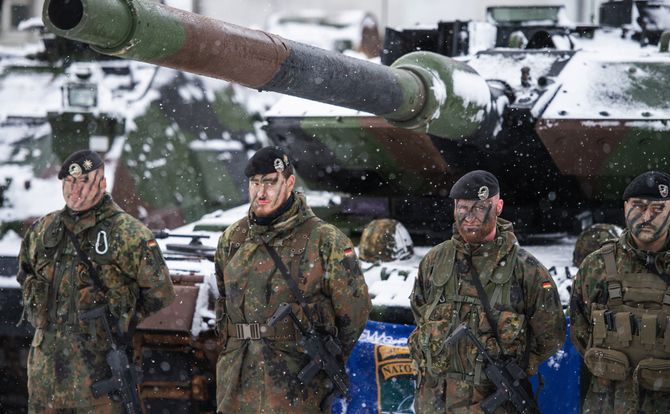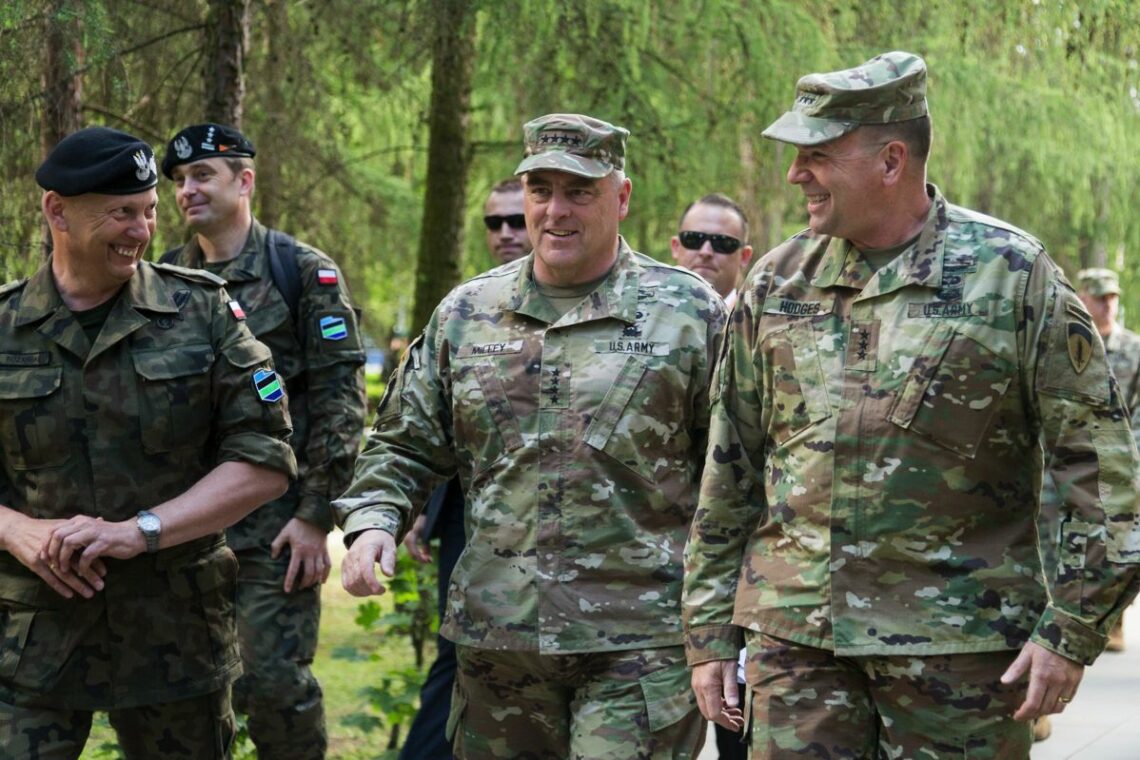Strategic defense: NATO’s conventional deterrent
The undeclared neo-Cold War between Russia and the West mixes 21st-century techniques with traditional forms of military confrontation. As arms races, proxy wars, and nuclear blackmail stage a comeback, NATO must rethink its deterrence. Yet even a beefed-up force will prove ineffective if NATO chooses the wrong defensive strategy.

In a nutshell
- New threats have made conventional defense a crucial element of NATO’s deterrent
- Non-territorial aggression makes the choice of defensive strategy even more difficult
- Strategies of preemptive attack and defense in depth are politically unacceptable
- Frontal defense has military drawbacks, but can be adapted to the alliance’s needs
The undeclared, hybrid Cold War between Russia and the West shows no signs of abating. Instead, it seems to be intensifying and spreading into new theaters. This includes cutting-edge threats such as hybrid or below-the-threshold operations, cyberattacks and cyber defense, and information warfare through social media.
However, we are also seeing a comeback of more traditional, 20th-century forms of confrontation dating back to the first Cold War: arms races, staged military incidents, proxy wars, nuclear blackmail and deterrence, and containment strategies. One of the latest manifestations is the decision to withdraw from the Intermediate-Range Nuclear Forces (INF) Treaty, which may widen the current arms race in strategic nuclear weapons to shorter-range systems as well.
Conventional deterrence
These developments cast a new light on the problem of deterrence and conventional defense. NATO, and especially its eastern members, are already responding to the neo-Cold War challenges from Russia. Decisions have been taken to meet and contain the growing threat. The past three NATO summits – in Newport (2014), Warsaw (2016) and Brussels (2017) – devoted much attention to these risks, resulting in steadily increasing military deployments on the alliance’s eastern flank.
Changes in the defense postures of frontline states can also be observed. Poland, for example, is shifting some of its armored units from west to east, creating a territorial defense force, adding a new mechanized division to its regular ground forces and building up its missile defenses. The Polish government is also trying to secure a permanent U.S. military presence on its territory. Other countries want the same thing, especially the Baltic states (Estonia, Latvia and Lithuania) and Romania, which are the most exposed to Russian pressure.
Russian military analysts have suggested non-territorial aggression as a possible model for future operations.
All this activity can be characterized as a reactive and operational response to emerging threats. There is no question, however, that NATO also needs a broader, more forward-looking review of its strategic approach. Given the changing conditions of the hybrid Cold War, the alliance requires a new strategic concept. While work on such a document should begin as soon as possible, there is little evidence that member countries have any desire to do so.
Risk profile
The various threats to NATO in Europe can be boiled down to two categories. The first is non-territorial aggression, or a military campaign not designed to take ground. This type of operation – sometimes called “non-contact war” – has been suggested as a possible model for future operations by Russian military analysts. The objective would be to sufficiently disorganize and damage the defending country so that it accepts a forced political settlement, thus avoiding the need for a prolonged and costly occupation of its territory. Non-territorial aggression could include:
- Below-the-threshold operations (info wars, employing “useful idiots” to organize civil unrest or street demonstrations, clandestine missions by special forces or “little green men”) that imperceptibly ramp up into hybrid warfare
- Cyberattacks targeted at the political leadership and military command and control systems
- Selective, precision bombardment by long-range weapons, including missiles, aircraft and “smart” artillery systems
- Commando raids on key defense installations
The second category is territorial aggression, which can take the form of a limited conflict (in terms of space, time, objectives and forces used) or all-out war. Russian military doctrine does not rule out limited wars of aggression when carried out with the benefit of surprise and protected by a nuclear umbrella (the so-called “escalate-to-deescalate” doctrine using tactical nuclear weapons). Full-scale war, which would be tremendously destructive to both sides, is a rather unlikely possibility that might occur through misjudgment (for example, about each side’s ability to contain a limited nuclear exchange), accident (e.g. a malfunction in the command system of strategic nuclear forces), or unforeseen intervention by third parties.

Defensive concepts
The defender always has options, provided he has planned and prepared in advance. Military theory recognizes three basic forms of strategic defense. Each emphasizes a different dimension in the basic triad of military conflict – strength, space and time.
- Preemptive strikes (or spoiling attacks) allow the defender to whittle down the strength of a prospective aggressor before he moves
- Frontal defense (also known as linear or positional defense) is designed to hold ground
- Defense in depth trades space for time through the use of maneuver; its operational goal is to sustain a durable defense
Preemptive strikes are an effective strategy against both non-territorial and territorial aggression, but extremely risky and difficult to execute. Above all, they require sustained and heavy investment in advanced systems designed to detect surprise attacks (including intelligence, military reconnaissance and surveillance, concealment and deception, and electronic warfare capabilities) long-range precision weaponry (missiles, aircraft, “smart” artillery, satellite-guided targeting) and quick-reaction forces, especially special operations, amphibious and airborne assault units.
Only an army with these powerful information-gathering and assault capabilities (requiring ultramodern equipment) can count on being able to effectively disrupt an aggressor’s preparations, forcing a delay or even cancellation of a planned attack. The Israeli Defense Forces show that such results are achievable, though they are easier to obtain against technologically less advanced opponents. As a rule, countries that rely on the doctrine of preemptive attack to deter aggression should enjoy at least military parity with their adversaries.
Frontal or linear defense works against territorial aggression but is ineffective against non-territorial attacks. This strategic concept requires the main body of the defending forces to be deployed well forward along a potential aggressor’s likely axes of advance, to halt the attack as close as possible to the border and keep friendly territory from being occupied. Reserves are used to reinforce the main line of resistance.
Linear defense has been condemned by just about every theorist of war from Sun Tzu to Carl von Clausewitz.
The weakness of linear defense is that uncertainty about the location of the enemy’s main thrust forces the defender to cover every threatened spot, resulting in an overstretched front line. Only strong intelligence-gathering capabilities (as with the preemptive strike strategy) would allow timely deployment of the bulk of the defending force against the opponent’s main line of attack. Otherwise, the defender is doomed to a strung-out cordon along the entire border. This method has been condemned by just about every theorist and practitioner of war – from Sun Tzu to Carl von Clausewitz – as the weakest form of defense. Piercing the line at any point must lead to the encirclement of the defending force near the border and rapid loss of the war (as shown by France’s two catastrophic defeats at Sedan in 1870 and 1940).

Defense in depth is essentially a way to buy time with space. It allows the defender to avoid quick defeat at the hands of a stronger opponent, dodging the impact of his first blow by withdrawing into the strategic hinterland. It is also a method for minimizing the effect of surprise and the aggressor’s advantage of choosing time and place.
In this concept, defense in the threatened forward areas is assigned to a screening force, whose job is to identify, channel and delay the enemy’s chief thrust, thus giving the main body time to organize an effective defense further back and prepare a counterattack. The strategic deployment is a reverse image of frontal defense: light units are positioned forward along the key avenues of attack, while the main force is held back, initially dispersed but capable of rapid concentration against the enemy’s main effort. As a bonus, deep deployments of this sort are better suited to coping with non-territorial aggression than frontal or linear defenses.
Scenarios
Scenario 1: Preemption
Which form of strategic defense best serves NATO’s need for an effective deterrent under the current circumstances, when the most probable threat is a limited surprise attack?
NATO certainly has the capability to stage a strategic preemptive strike. The strength and quality of its armed forces is sufficient to organize such an operation with the necessary intelligence and assault assets. There are two big “buts,” however – political will and operational feasibility.
It seems highly doubtful that any multinational defense organization could decide consensually on a preemptive strike before war erupts, especially if it was to be elevated to the status of strategic doctrine. This sort of determination is much easier to make on the national level. Examples include Israel and the use of U.S. military units in antiterrorist operations under Presidents George W. Bush and Barack Obama.
It is true that some nuclear powers have not ruled out a first strike, which is perhaps why none has proposed banning the doctrine. However, it is hard to imagine NATO making such a decision, even using conventional weapons, if it meant running the risk of full-scale war. Quite simply, this would require the alliance to accept the need for a nuclear first strike, as well as for concentrating large numbers of assault troops near the border – either on a permanent basis or immediately before the outbreak. Neither option seems plausible today.
The second consideration is whether a preemptive strike is a suitable and proportionate response to limited territorial aggression, let alone non-territorial, below-the-threshold attacks. Launching a spoiling attack against a nuclear power necessarily involves readiness for total war, since the availability of tactical nuclear weapons makes the line between conventional and nuclear war very fine indeed. As a practical matter, that alone eliminates preemptive action as a strategic option for NATO.
However, this does not mean spoiling attacks should be entirely removed from the alliance’s doctrine. They can and are needed during wartime as a standard element in the military repertoire. In practice, this means that preemptive strikes belong in NATO’s operational toolbox, not the strategic one.
Scenario 2: Forward defense
As for the effectiveness of frontal defense against attacks of various types (full-scale invasion, limited war, territorial or non-territorial aggression), the first thing to note is that early deployment of the main force in the forward echelon is extraordinarily risky in the event of all-out war. In that case, an attacker who achieves strategic surprise could wipe out the bulk of NATO’s combat strength in the very first phase of an East European campaign. If conventional weapons were used, the result might be a political collapse (rupturing the NATO alliance) or a desperate and protracted defensive struggle before a counterattack could be mounted. The only other option would be to respond with nuclear weapons – an unimaginable disaster for both sides.
Assuming that the nuclear deterrent minimizes the chance of an all-out conflict, forward deployment of major NATO units could indeed discourage an aggressor bent on limited war. Frontal defense would then provide a strategic opportunity to avoid a shooting war and keep the current neo-Cold War confrontation from getting too hot.
Will the alliance decide to implement this strategy? Much as with a preemptive strike, the probability is not large. For now, it seems the Western alliance lacks the political will to override arguments that a major redeployment to Eastern Europe will provoke an analogous reaction on the Russian side. Moreover, stationing a sizeable conventional force on NATO’s eastern flank – as was done during the first Cold War – would require a substantial increase in defense spending, well above the 2 percent of gross domestic product (GDP) that now seems so difficult to achieve.
Scenario 3: Flexible defense
The maneuver philosophy embodied in defense in depth seems to be the obvious strategy for a collective security organization. Note that time is the crucial strategic element for NATO; the alliance already has plenty of size and space. Time is essential to make collective decisions and concentrate widely dispersed forces. It should be remembered that NATO’s larger formations (corps and army level) are all multinational; their components must be assembled from all over Europe and even North America. The transatlantic supply line to the United States will be critical, just as it was during the two world wars. NATO can harness tremendous strength if it is given sufficient time. That is what defense in depth provides.
Once again, however, politics gets in the way of strategy. The strategic benefits of defense in depth are offset by its political liabilities. NATO’s frontline countries will undoubtedly object, fearing that the alliance could lose its nerve and push for a cease-fire – leaving the aggressor in control of conquered territories, either permanently or as a bargaining chip in subsequent negotiations. These concerns loom even larger in the case of limited aggression – a particular worry for the Baltic states and Poland. All of this suggests that a flexible defense based on maneuver and buying time for an eventual counterattack may be considered too risky politically by NATO’s eastern members.
Double duty
Caught between these contradictory military and political logics, NATO will try to strike an acceptable compromise between the two. One solution could be to deploy a screening force in the northeastern theater (the Baltic states and Poland) that would be strong enough to discourage anything short of a full-scale attack. Even this would mean increasing current force levels in the region.
This front-line deployment would serve as a deterrent to limited aggression, while at the same time constituting a screening force for defense in depth in case of a full-scale war. Most likely, NATO would form a separate headquarters for this first-echelon force on the northeast flank. It would be logical for the wartime commander of the Polish armed forces (the Armed Forces Operational Command) to “wear two hats” by leading this formation as well.
At least in theory, such an arrangement could offer NATO the best of both worlds. Polish-American talks on an increased U.S. military presence in Eastern Europe are already proceeding along those lines. However, for the redeployment to be effective as a strategic deterrent, troops from NATO member countries in Western Europe would also need to take part.
Here again the military and political logics intertwine. Strengthening NATO’s northeastern flank with a few more American troops will count for little without a matching European involvement. If the contribution is disproportionate, it could even put strain on the alliance and constitute a sign of weakness. The Trump administration has been increasingly forthright about the need for burden-sharing, while any lack of unity within NATO over eastern deployments would simply signal to Russia that the alliance is divided. That would be the very opposite of deterrence.
Whether European NATO members have the political will for such a step is a separate question. On an individual basis, there are some likely candidates – the United Kingdom may be willing to increase its presence in the Baltic states, and perhaps Romania, as a frontline country, would find it advantageous to contribute as well. Whatever the political mood, however, NATO can ill afford to keep putting off its discussion of a new strategic concept. To be effective, the new strategy should demonstrate the alliance’s determination and strength along its most likely potential battlefront.








